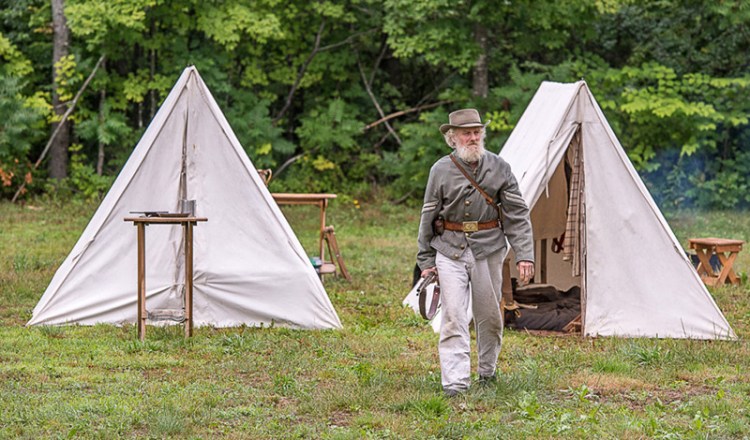MINOT — Never stop learning, says the surgeon for the 3rd Maine Regiment.
“That’s why we’re doing this, we’re fascinated — so much to read and learn,” said Maj. Scott Scroggins of Lisbon Falls.
He was among the Civil War re-enactors massed under canvas tents as the rain fell on the encampment on the field surrounding the Minot Historical House on Saturday.

Bayden Cyr-Guzowski, 9, of Minot, gets fitted with Civil War-era costuming by Sandra Swatsky on Saturday at the the second annual Civil War Encampment hosted by the Minot Historical Society. Andree Kehn/Sun Journal
Three re-enactment units, the 5th Connecticut Volunteer Infantry, Company A of the 3rd Maine Regiment and the Maine Rebels 15th Alabama Company G are camping on Center Minot Hill Road through Sunday, providing glimpses of military life during the American Civil War, 1861 through 1865.
Capt. Matt Bray, Company A commander, of Litchfield, said interest in re-enacting really took hold in the late 1980s when the movie “Glory” was released and Ken Burns Civil War documentary aired on PBS.
Bray joined when he was 14 years old.
“But we’re not out here playing like the guys in the movie,” he said. “I think that’s how it might have started to an extent, that’s kind of how I felt when I joined. I think it’s different now. I think it is very different now.”
“Firsthand resources,” Bray said, ”that’s what changed it. Firsthand resources, not some book that was written by some guy who tried to pump himself up, trying to get elected to public office” following the war.
The hobby of re-enacting Bray said, “is taking a little bit of a turn toward authenticity, trying to be, ‘Hey, let’s do it right.’”
Steve Peterson of Auburn, a member of the 3rd for 25 years, echoed Bray’s comments. “I find stuff like that really cool. I just got done reading a book on a sergeant from the 2nd Michigan and he talks about his camp life in his personal journal. It ‘s the stuff we do and it was fascinating — what the men actually did and how they lived.”

Steve Peterson, left, chats with fellow Union officers Addam Moffett, Matt Bray and Thomas Pinette.
Scroggins said he spent several months “going through and culling all the first-person accounts I could come up with of the 17th Maine, the 16th Maine, the 3rd Maine, the 20th Maine, and I got all these letters describing the action,” Scroggins said.
Last year he visited the Gettysburg battle site with his 16-year-old daughter and stopped at all of the locations mentioned in the letters and read them aloud.
“It was hard for me to get through those letters,” he said. “Though I read through them a hundred times, reading the actual people’s words at the time was powerful stuff.”
Marty King of the 5th Connecticut can explain in detail the differences between the 1842 Springfield smooth bore musket and the Enfield rifle. Distances between Confederate and Union battle formations were often only 25 up to 100 yards.
Sandra Swatsky of Industry was representing a civilian of the time — “a woman of the South,” who follows her husband, an infantryman. “It was not that unusual. Their farms were burned, their crops destroyed, their animals eaten. They didn’t have anything to live on. They were displaced.”
On the Union side, Marcia Cylik of South Paris portrayed the postmaster. That job included writing letters for the soldiers and sending them home. Cylik became interested in the re-enactment by doing genealogical research on her great-great grandfather, Charles K. Sawyer. She came across his induction papers when he joined the 9th Maine regiment from Baldwin. He survived the war and is buried in Naples, Cylik said.
Her husband, Dick Cylik, is the steward to the surgeon. He said gauze bandages were not yet available during the Civil War.

Dick Cylik, portraying a Civil War-era hospital steward takes a break during the Civil War Encampment in Minot on Saturday. Behind him is the postmater’s tent. Andree Kehn/Sun Journal
“Back home, you had hundreds of women sitting in factories scrapping fabric to come up with the lint to be packaged in bundles,” then shipped to the regiments.
Cylik said the steward was also the dentist and the pharmacist, dispensing the 52 drugs that were issued in the military, “from coffee extract to mercury and morphine.”
Cylik came across a bent-over bayonet in hook shape, which Scroggins discovered was used to drag the dead from the battlefield.
“Some enterprising private at some point picked up a musket, bent the bayonet around so you could hook it into the leathers (uniform belts) and drag the body to the burial area,” Cylik said.
Scroggins said he has walked the field of Pickett’s Charge in Gettysburg. “It was pretty emotional.”
Send questions/comments to the editors.



Success. Please wait for the page to reload. If the page does not reload within 5 seconds, please refresh the page.
Enter your email and password to access comments.
Hi, to comment on stories you must . This profile is in addition to your subscription and website login.
Already have a commenting profile? .
Invalid username/password.
Please check your email to confirm and complete your registration.
Only subscribers are eligible to post comments. Please subscribe or login first for digital access. Here’s why.
Use the form below to reset your password. When you've submitted your account email, we will send an email with a reset code.